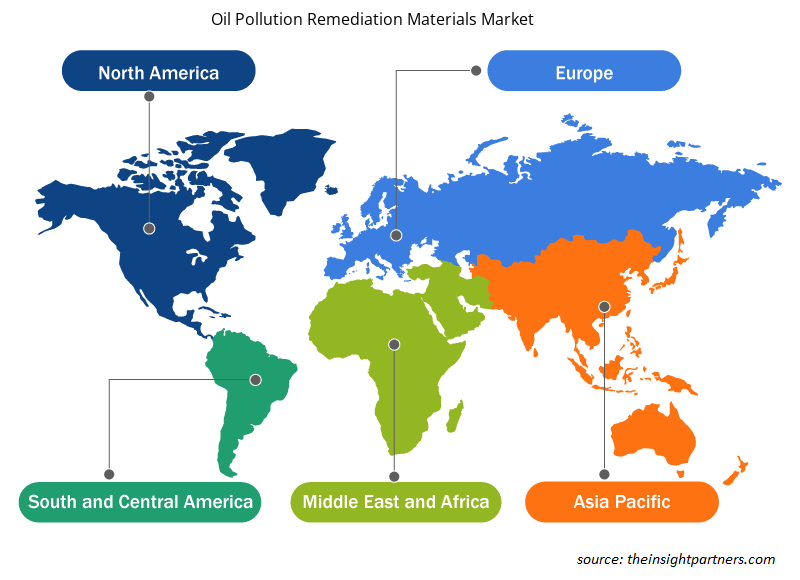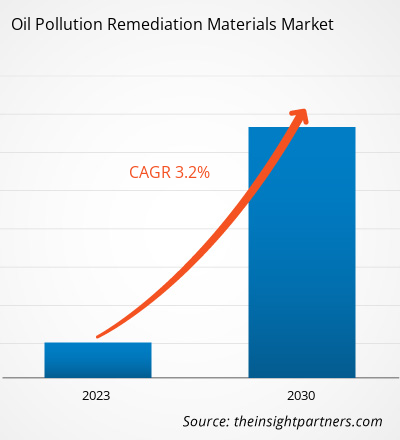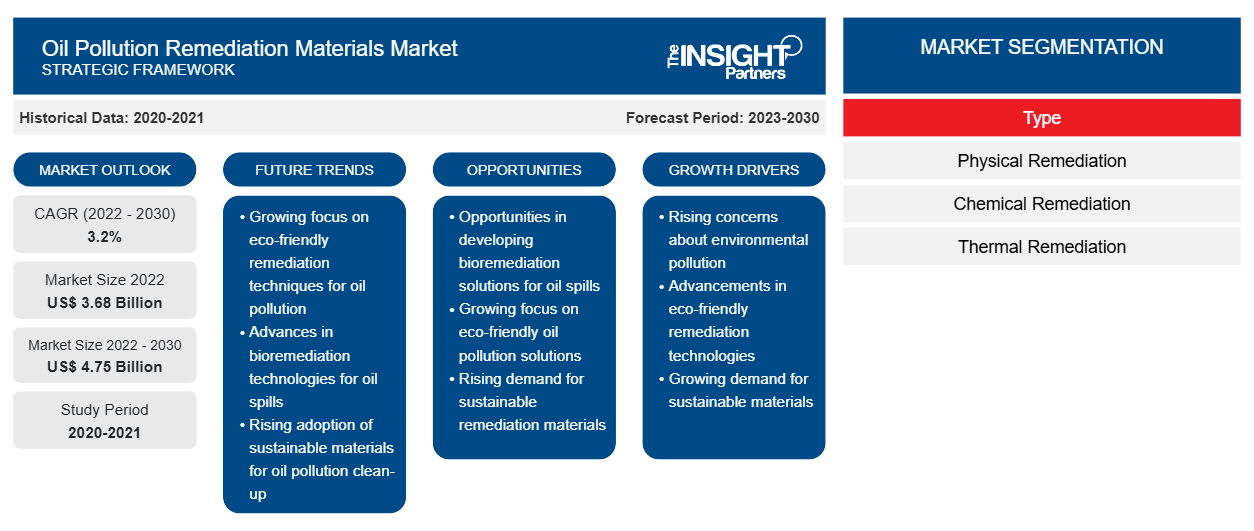[Forschungsbericht] Die Marktanalyse für Materialien zur Beseitigung von Ölverschmutzungen wurde im Jahr 2022 auf 3.684,36 Millionen US-Dollar geschätzt und soll bis 2030 4.749,56 Millionen US-Dollar erreichen; von 2022 bis 2030 wird eine durchschnittliche jährliche Wachstumsrate (CAGR) von 3,2 % erwartet.
Marktanalyse
Die Materialien zur Beseitigung von Ölverschmutzungen werden eingesetzt, um das hohe Risiko einer Verschmutzung von Gewässern durch die weltweit stattfindenden Ölexplorations-, Öltransport- und Industriebetriebsaktivitäten zu verringern. Die Sanierungstechniken werden hauptsächlich in physikalische, chemische, thermische und biologische Sanierung unterteilt. Sie gelten als äußerst wichtig für die Bekämpfung der Probleme von Ölverschmutzungen im Meer. Die physikalische Sanierung besteht aus Materialien wie Ölsperren, Skimmern und Adsorptionsmaterialien. Die chemischen Sanierungsmaterialien umfassen Dispergiermittel und Verfestiger.
Wichtige Faktoren, die das Wachstum des Marktes für Materialien zur Beseitigung von Ölverschmutzungen vorantreiben , sind die zunehmenden Offshore-Ölexplorations- und -transportaktivitäten sowie staatliche Vorschriften in Bezug auf die Vorbereitung auf und Reaktion auf Ölverschmutzungen. In den letzten Jahren haben Regierungen verschiedener Länder Vorschriften zur Beseitigung von Ölverschmutzungen erlassen, um eine schnelle und wirksame Reaktion auf Umweltnotfälle zu gewährleisten. Diese Vorschriften beschreiben in der Regel Verfahren, Technologien und Standards, die Unternehmen einhalten müssen, um Ölverschmutzungen einzudämmen, zu kontrollieren und zu beseitigen. Vorschriften legen oft die Art der Sanierungsmaterialien fest, die eingesetzt werden müssen, um die Umweltauswirkungen zu minimieren und eine wirksame Beseitigung zu gewährleisten. Der steigende Bedarf an wirksamer Beseitigung von Ölverschmutzungen treibt die Nachfrage nach Sanierungsmaterialien an.
Angesichts zunehmender Umweltbedenken und -vorschriften wird der Einsatz moderner und umweltfreundlicher Materialien zur Sanierung immer wichtiger. Bestimmte Absorptions-, Dispersions- und Sperrmittel müssen möglicherweise Sicherheits- und Wirksamkeitsstandards erfüllen, um den Einsatz umweltfreundlicher und effizienter Materialien bei der Bekämpfung von Ölverschmutzungen zu fördern. Regierungen und die Ölindustrie verfügen über Bereitschaftspläne für regelmäßige Maßnahmen zur Bekämpfung von Ölverschmutzungen. Regierungsauflagen zur unverzüglichen Bekämpfung von Ölverschmutzungen und zur Minimierung der ökologischen Auswirkungen haben die Nachfrage nach Absorptions-, Dispersions- und anderen Sanierungsmaterialien angetrieben. Im Jahr 2023 verschärfte die US-Umweltschutzbehörde im Rahmen des National Contingency Plan (NCP) der Bundesregierung die Standards zur Verbesserung der Maßnahmen zur Bekämpfung von Ölverschmutzungen in den US-Gewässern und angrenzenden Küsten. Die Standards umfassen die Entwicklung wirksamer Produkte zur Beseitigung von Ölverschmutzungen, wie z. B. chemische und biologische Wirkstoffe, sowie die Bereitstellung von Transparenz und Informationen im Zusammenhang mit der Verwendung dieser Produkte.
Erhöhte Offshore-Explorations- und Bohraktivitäten, der Transport von Öl über Pipelines oder Tanker sowie menschliche Fehler bei der Ölförderung und -lagerung erhöhen die Wahrscheinlichkeit von Ölunfällen. Laut der Internationalen Energieagentur erholte sich die weltweite Ölnachfrage im Jahr 2021, und bis 2025 wird Asien voraussichtlich 77 % der Ölnachfrage decken. Der Ölimportbedarf Asiens wird bis 2025 voraussichtlich 31 Millionen Barrel pro Tag übersteigen. Die Regierungen verschiedener Länder im asiatisch-pazifischen Raum haben Ölprojekte initiiert, um der steigenden Nachfrage nach Öl in der Region gerecht zu werden. Im Jahr 2023 meldeten PETRONAS und seine Petroleum Arrangement Contractors 19 Öl- und Gasexplorationsfunde und zwei erfolgreiche Explorations- und Bewertungsergebnisse, die zu mehr als 1 Milliarde Barrel Öläquivalent an neuen Ressourcen für Malaysia beitrugen. Dies ist das Ergebnis eines intensivierten Explorationsprogramms, das in den letzten Jahren durchgeführt wurde und in dessen Rahmen 25 Bohrungen durchgeführt wurden. Seit 2015 ist dies die höchste Anzahl an Explorationsbohrungen, die in einem einzigen Jahr gebohrt wurden.
Wachstumstreiber und Herausforderungen
Laut einem im Januar 2024 von der US Energy Information Administration veröffentlichten Bericht ist die Rohölproduktion seit der COVID-19-Pandemie am 9. Januar 2024 gestiegen, womit ein zweijähriger Rückgang umgekehrt wurde. Die US- Rohölproduktion stieg von 11,27 Millionen Barrel/Tag im Jahr 2021 auf 13,21 Millionen Barrel/Tag im Jahr 2023 und soll bis 2024 13,44 Millionen Barrel/Tag erreichen. Laut der Canada Energy Regulator wird der Großteil des in Kanada produzierten Rohöls über Pipelines aus den westlichen Provinzen zu Raffinerien in den USA, Ontario und Quebec transportiert. Laut dem 2023 von Bruegel AISBL veröffentlichten Bericht gehörte Russland im Jahr 2021 zu den fünf größten Energieproduzenten und -verbrauchern weltweit. Im selben Jahr produzierte es 595,2 Millionen Tonnen Rohöl, von denen 286,6 Millionen Tonnen exportiert wurden. Somit treibt die zunehmende Offshore-Ölexplorations- und -transportaktivität den Markt für Materialien zur Ölsanierung an.
Passen Sie diesen Bericht Ihren Anforderungen an
Sie erhalten kostenlos individuelle Anpassungen an jedem Bericht, einschließlich Teilen dieses Berichts oder einer Analyse auf Länderebene, eines Excel-Datenpakets sowie tolle Angebote und Rabatte für Start-ups und Universitäten.
-
Holen Sie sich die wichtigsten Markttrends aus diesem Bericht.Dieses KOSTENLOSE Beispiel umfasst eine Datenanalyse von Markttrends bis hin zu Schätzungen und Prognosen.
Berichtssegmentierung und Umfang
Die „Globale Marktprognoseanalyse für Ölverschmutzungssanierungsmaterialien“ wurde unter Berücksichtigung der folgenden Segmente durchgeführt: Typ und Geografie. Der Bericht enthält wichtige Statistiken zur Verwendung von Ölverschmutzungssanierungsmaterialien auf der ganzen Welt sowie deren Nachfrage in wichtigen Regionen und Ländern. Darüber hinaus bietet der Bericht eine qualitative Bewertung der Faktoren, die die Marktleistung in wichtigen Regionen und Ländern beeinflussen. Er enthält auch eine umfassende Analyse der führenden Akteure auf dem Markt für Ölverschmutzungssanierungsmaterialien und ihrer wichtigsten strategischen Entwicklungen. Eine Analyse der Marktdynamik ist ebenfalls enthalten, um die wichtigsten Antriebsfaktoren, Markttrends und lukrativen Möglichkeiten zu identifizieren, die wiederum zur Erzielung höherer Umsätze beitragen würden.
Die Ökosystemanalyse und Porters Fünf-Kräfte-Analyse bieten eine 360-Grad-Ansicht des globalen Marktes, die dabei hilft, die gesamte Lieferkette und die verschiedenen Faktoren zu verstehen, die das Wachstum des Marktes für Materialien zur Ölverschmutzungssanierung beeinflussen.
Segmentanalyse
Der globale Markt für Ölsanierungsmaterialien ist nach Typ segmentiert. Basierend auf dem Typ ist der Markt in physikalische Sanierung (Sperren, Skimmer und Adsorptionsmaterialien), chemische Sanierung (Dispergiermittel und Verfestiger), thermische Sanierung und Biosanierung segmentiert . Das Segment der physikalischen Sanierung hält den größten Marktanteil an Ölsanierungsmaterialien. Die physikalische Sanierung wird häufig verwendet, um Ölverschmutzungen in einer Wasserumgebung zu kontrollieren. Sie wird verwendet, um Öl, das auf der Wasseroberfläche verbleibt, einzudämmen und zurückzugewinnen, ohne seine Eigenschaften zu verändern. Sie wird auch hauptsächlich als Barriere verwendet, um die Ausbreitung von Ölverschmutzungen zu kontrollieren, ohne seine physikalischen und chemischen Eigenschaften zu verändern. Der häufigste Vorteil der Verwendung physikalischer Sanierungsmethoden besteht darin, dass Öl seine Eigenschaften behält. Daher kann es auch in Zukunft noch raffiniert und verwendet werden, wodurch Abfall reduziert und möglicherweise finanzielle Verluste gemildert werden. Der physikalische Sanierungsprozess umfasst Sperren, Skimmer und Adsorptionsmaterialien.
Regionale Analyse
Der Bericht bietet einen detaillierten Überblick über den globalen Markt für Materialien zur Beseitigung von Ölverschmutzungen in Bezug auf fünf große Regionen – Nordamerika, Europa, Asien-Pazifik (APAC), Naher Osten und Afrika (MEA) sowie Süd- und Mittelamerika. Der Nahe Osten und Afrika (MEA) hatten den größten globalen Marktanteil an Materialien zur Beseitigung von Ölverschmutzungen und wurden 2022 auf über 1.500 Millionen US-Dollar geschätzt. Der Nahe Osten und Afrika (MEA) ist durch die Präsenz großer Ölbohrunternehmen gekennzeichnet, die in der Region tätig sind. Der Markt im Asien-Pazifik-Raum (APAC) wird voraussichtlich bis 2030 über 1.000 Millionen US-Dollar erreichen. Der Markt in Nordamerika wird voraussichtlich von 2022 bis 2030 eine durchschnittliche jährliche Wachstumsrate von ~3 % verzeichnen. Der Nahe Osten und Afrika sind die Heimat großer Rohölreserven; die Zahl der Rohölexplorationsaktivitäten ist in dieser Region in den letzten Jahren deutlich gestiegen. Entwicklungen bei Technologien, die bei der Ölexploration und -produktion helfen, haben das Risiko von Ölverschmutzungen erhöht und die Nachfrage nach Materialien und Dienstleistungen zur Beseitigung von Ölverschmutzungen angekurbelt. Somit tragen technologische Entwicklungen zum wachsenden Markt für Materialien zur Beseitigung von Ölverschmutzungen im Nahen Osten und in Afrika bei.
Regionale Einblicke in den Markt für Materialien zur Ölverschmutzungssanierung
Die regionalen Trends und Faktoren, die den Markt für Ölverschmutzungssanierungsmaterialien während des gesamten Prognosezeitraums beeinflussen, wurden von den Analysten von Insight Partners ausführlich erläutert. In diesem Abschnitt werden auch Marktsegmente und Geografie für Ölverschmutzungssanierungsmaterialien in Nordamerika, Europa, im asiatisch-pazifischen Raum, im Nahen Osten und Afrika sowie in Süd- und Mittelamerika erörtert.

- Erhalten Sie regionale Daten zum Markt für Materialien zur Beseitigung von Ölverschmutzungen
Umfang des Marktberichts zu Materialien zur Ölverschmutzungssanierung
| Berichtsattribut | Details |
|---|---|
| Marktgröße im Jahr 2022 | 3,68 Milliarden US-Dollar |
| Marktgröße bis 2030 | 4,75 Milliarden US-Dollar |
| Globale CAGR (2022 - 2030) | 3,2 % |
| Historische Daten | 2020-2021 |
| Prognosezeitraum | 2023–2030 |
| Abgedeckte Segmente |
Nach Typ
|
| Abgedeckte Regionen und Länder |
Nordamerika
|
| Marktführer und wichtige Unternehmensprofile |
|
Marktteilnehmerdichte: Der Einfluss auf die Geschäftsdynamik
Der Markt für Materialien zur Beseitigung von Ölverschmutzungen wächst rasant. Dies wird durch die steigende Nachfrage der Endnutzer aufgrund von Faktoren wie sich entwickelnden Verbraucherpräferenzen, technologischen Fortschritten und einem größeren Bewusstsein für die Vorteile des Produkts vorangetrieben. Mit der steigenden Nachfrage erweitern Unternehmen ihr Angebot, entwickeln Innovationen, um die Bedürfnisse der Verbraucher zu erfüllen, und nutzen neue Trends, was das Marktwachstum weiter ankurbelt.
Die Marktteilnehmerdichte bezieht sich auf die Verteilung der Firmen oder Unternehmen, die in einem bestimmten Markt oder einer bestimmten Branche tätig sind. Sie gibt an, wie viele Wettbewerber (Marktteilnehmer) in einem bestimmten Marktraum im Verhältnis zu seiner Größe oder seinem gesamten Marktwert präsent sind.
Die wichtigsten Unternehmen auf dem Markt für Materialien zur Beseitigung von Ölverschmutzungen sind:
- Sarva Bio Remed LLC
- Oil Technics GmbH
Haftungsausschluss : Die oben aufgeführten Unternehmen sind nicht in einer bestimmten Reihenfolge aufgeführt.

- Überblick über die wichtigsten Akteure auf dem Markt für Materialien zur Ölverschmutzungssanierung
Wettbewerbslandschaft und Schlüsselunternehmen
Sarva Bio Remed LLC, Oil Technics Ltd, Ansell Ltd, Oil-Dri Corp of America, Verde Environmental Group Ltd, Ecolab Inc, Cosco Shipping Heavy Industry Co Ltd, Regenesis, TOLSA SA und CL Solutions LLC gehören zu den prominenten Akteuren, die im Marktbericht zu Materialien zur Ölverschmutzungssanierung vorgestellt werden. Darüber hinaus wurden im Rahmen der Studie mehrere andere Akteure untersucht und analysiert, um einen ganzheitlichen Überblick über den Markt und sein Ökosystem zu erhalten. Der Marktbericht zu Materialien zur Ölverschmutzungssanierung umfasst auch die Positionierung und Konzentration der Unternehmen, um die Leistung von Wettbewerbern/Akteuren auf dem Markt zu bewerten.
Branchenentwicklungen und zukünftige Chancen
Nachfolgend sind die Initiativen der wichtigsten Akteure auf dem Markt für Materialien zur Ölverschmutzungssanierung aufgeführt:
Im November 2022 investierte Ansell Ltd rund 80 Millionen US-Dollar in die Greenfield-Produktionsanlage in Indien.
- Historische Analyse (2 Jahre), Basisjahr, Prognose (7 Jahre) mit CAGR
- PEST- und SWOT-Analyse
- Marktgröße Wert/Volumen – Global, Regional, Land
- Branchen- und Wettbewerbslandschaft
- Excel-Datensatz
Aktuelle Berichte
Verwandte Berichte
Erfahrungsberichte
Grund zum Kauf
- Fundierte Entscheidungsfindung
- Marktdynamik verstehen
- Wettbewerbsanalyse
- Kundeneinblicke
- Marktprognosen
- Risikominimierung
- Strategische Planung
- Investitionsbegründung
- Identifizierung neuer Märkte
- Verbesserung von Marketingstrategien
- Steigerung der Betriebseffizienz
- Anpassung an regulatorische Trends























 Kostenlose Probe anfordern für - Markt für Materialien zur Beseitigung von Ölverschmutzungen
Kostenlose Probe anfordern für - Markt für Materialien zur Beseitigung von Ölverschmutzungen